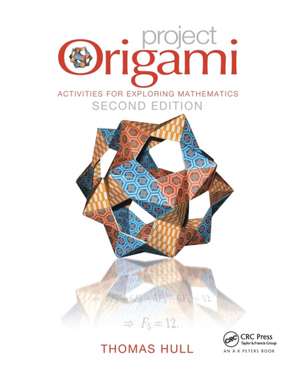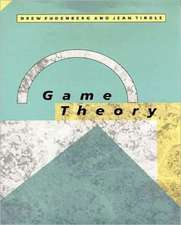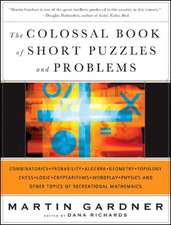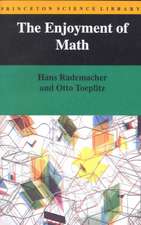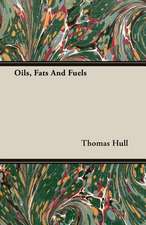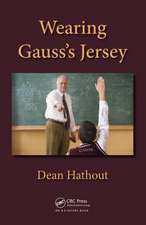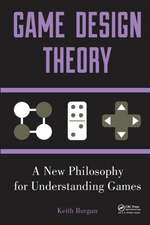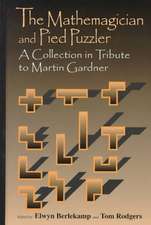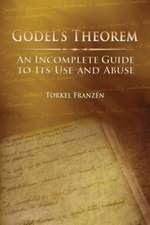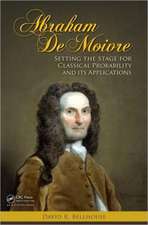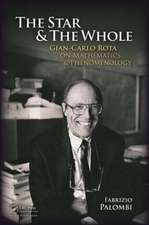Project Origami: Activities for Exploring Mathematics, Second Edition: AK Peters/CRC Recreational Mathematics Series
Autor Thomas Hullen Limba Engleză Paperback – 21 dec 2012
The book contains detailed plans for 30 hands-on, scalable origami activities. Each activity lists courses in which the activity might fit, includes handouts for classroom use, and provides notes for instructors on solutions, how the handouts can be used, and other pedagogical suggestions. The handouts are also available on the book’s CRC Press web page.
Reflecting feedback from teachers and students who have used the book, this classroom-tested text provides an easy and entertaining way for teachers to incorporate origami into a range of college and advanced high school math courses.
Visit the author’s website for more information.
| Toate formatele și edițiile | Preț | Express |
|---|---|---|
| Paperback (1) | 436.55 lei 6-8 săpt. | +36.78 lei 7-13 zile |
| CRC Press – 21 dec 2012 | 436.55 lei 6-8 săpt. | +36.78 lei 7-13 zile |
| Hardback (1) | 1344.80 lei 6-8 săpt. | |
| Taylor & Francis Ltd. – 28 iun 2017 | 1344.80 lei 6-8 săpt. |
Din seria AK Peters/CRC Recreational Mathematics Series
-
 Preț: 183.29 lei
Preț: 183.29 lei -
 Preț: 443.72 lei
Preț: 443.72 lei -
 Preț: 264.81 lei
Preț: 264.81 lei -
 Preț: 295.22 lei
Preț: 295.22 lei -
 Preț: 228.42 lei
Preț: 228.42 lei -
 Preț: 406.36 lei
Preț: 406.36 lei -
 Preț: 263.19 lei
Preț: 263.19 lei -
 Preț: 207.28 lei
Preț: 207.28 lei -
 Preț: 208.29 lei
Preț: 208.29 lei -
 Preț: 238.56 lei
Preț: 238.56 lei - 8%
 Preț: 571.47 lei
Preț: 571.47 lei -
 Preț: 411.95 lei
Preț: 411.95 lei -
 Preț: 314.00 lei
Preț: 314.00 lei -
 Preț: 206.15 lei
Preț: 206.15 lei -
 Preț: 438.98 lei
Preț: 438.98 lei -
 Preț: 325.71 lei
Preț: 325.71 lei -
 Preț: 167.74 lei
Preț: 167.74 lei - 11%
 Preț: 510.03 lei
Preț: 510.03 lei -
 Preț: 249.98 lei
Preț: 249.98 lei -
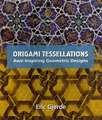 Preț: 265.90 lei
Preț: 265.90 lei -
 Preț: 235.30 lei
Preț: 235.30 lei -
 Preț: 207.03 lei
Preț: 207.03 lei -
 Preț: 190.55 lei
Preț: 190.55 lei - 8%
 Preț: 474.19 lei
Preț: 474.19 lei -
 Preț: 231.71 lei
Preț: 231.71 lei - 9%
 Preț: 625.90 lei
Preț: 625.90 lei -
 Preț: 386.62 lei
Preț: 386.62 lei -
 Preț: 335.54 lei
Preț: 335.54 lei -
 Preț: 242.40 lei
Preț: 242.40 lei - 8%
 Preț: 589.10 lei
Preț: 589.10 lei -
 Preț: 208.37 lei
Preț: 208.37 lei -
 Preț: 338.77 lei
Preț: 338.77 lei - 33%
 Preț: 1073.29 lei
Preț: 1073.29 lei - 33%
 Preț: 1079.19 lei
Preț: 1079.19 lei -
 Preț: 311.11 lei
Preț: 311.11 lei - 23%
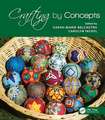 Preț: 261.04 lei
Preț: 261.04 lei - 15%
 Preț: 551.47 lei
Preț: 551.47 lei -
 Preț: 316.91 lei
Preț: 316.91 lei - 22%
 Preț: 278.50 lei
Preț: 278.50 lei - 18%
 Preț: 1222.28 lei
Preț: 1222.28 lei - 25%
 Preț: 185.21 lei
Preț: 185.21 lei
Preț: 436.55 lei
Preț vechi: 513.59 lei
-15% Nou
Puncte Express: 655
Preț estimativ în valută:
77.25€ • 90.58$ • 67.84£
77.25€ • 90.58$ • 67.84£
Carte tipărită la comandă
Livrare economică 04-18 februarie 26
Livrare express 31 decembrie 25 - 06 ianuarie 26 pentru 46.77 lei
Preluare comenzi: 021 569.72.76
Specificații
ISBN-13: 9781466567917
ISBN-10: 1466567910
Pagini: 364
Ilustrații: 379 b/w images, 4 tables and Over 50
Dimensiuni: 203 x 254 x 23 mm
Greutate: 0.73 kg
Ediția:Revizuită
Editura: CRC Press
Colecția A K Peters/CRC Press
Seria AK Peters/CRC Recreational Mathematics Series
ISBN-10: 1466567910
Pagini: 364
Ilustrații: 379 b/w images, 4 tables and Over 50
Dimensiuni: 203 x 254 x 23 mm
Greutate: 0.73 kg
Ediția:Revizuită
Editura: CRC Press
Colecția A K Peters/CRC Press
Seria AK Peters/CRC Recreational Mathematics Series
Public țintă
Academic/professional/technical: Postgraduate. Academic/professional/technical: Research and professionalCuprins
Introduction. Folding Equilateral Triangles in a Square. Origami Trigonometry. Dividing a Length into Equal Nths: Fujimoto Approximation. Dividing a Length into Equal Nths Exactly. Origami Helix. Folding a Parabola. Can Origami Trisect an Angle? Solving Cubic Equations. Lill’s Method. Folding Strips into Knots. Haga’s "Origamics." Modular Star Ring. Folding a Butterfly Bomb. Molly’s Hexahedron. Business Card Modulars. Five Intersecting Tetrahedra. Making Origami Buckyballs. Making Origami Tori. Modular Menger Sponge. Folding and Coloring a Crane. Exploring Flat Vertex Folds.Impossible Crease Patterns. Folding a Square Twist. Counting Flat Folds. Self-Similar Wave. Matrix Model of Flat Vertex Folds. Matrix Model of 3D Vertex Folds. Origami and Homomorphisms. Rigid Folds 1: Gaussian Curvature. Rigid Folds 2: Spherical Trigonometry. Appendix. Bibliography. Index.
Recenzii
Praise for the First Edition:
For anyone who wants to enliven their class activities, this book gives wonderfully clear instructions for hands-on pager-folding activities, and specific suggestions as how to encourage students to ask questions, and to answer them, in the spirit of really ‘doing mathematics’ … I will use it next time I teach the Polya Enumeration Theorem.
—Mathematical Reviews, February 2008
Is it possible to use origami in the higher level mathematics classroom? An affirmative answer is given by Thomas Hull’s book Project Origami: Activities for Exploring Mathematics. Based on Hull’s extensive experience of combining origami and mathematics teaching over the last fifteen years, it aims to help the teacher bring origami into the mathematics classroom, at the high school, college, and university level.
—Helena Verrill, AMS Notices, May 2007
Thomas Hull … is one of the country’s foremost researchers in origami mathematics—a subject making the slow transition from the ghetto of recreational math, where Sudoku and Rubik’s Cube dwell, to the rarified air of legitimate research topic … The fun part is watching the mash-up of intellectual analysis and paper creativity … but what really drives him, he says, is understanding what’s happening underneath each figure.
—David Brooks, Nashuatelegraph.com, May 2007
In his efforts to collect everything that he could find linking origami and math (and in his own research efforts), Hull has discovered not only the obvious links between origami and geometry but also intriguing intersections of origami with other fields of mathematics, such as algebra, number theory, and combinatorics.
—Ivars Peterson, Science News, June 2006
Overall, this book is an excellent resource for mathematics educators who would like to include some hands-on experimentation in their teaching.
—Steven Frankel, MAA Reviews, July 2006
This is probably the most comprehensive study of mathematical paperfolding produced in book form to date. … Along with theorems and formulas, there are copious notes for instructors, making the book more a teachers’ manual than a recreational pursuit. Even so it will reward a study even by those wishing solely to produce decorative forms.
—John Cunliffe, ELFA and British Origami Society
This book shows you how and explains how! … The book is neatly presented and is designed to work as a sourcebook for teachers wishing to use origami in the classroom, but is easily accessible to anyone.
—Dennis Walker, British Origami Society
Thomas Hull has written a truly wonderful book … Project Origami is full of surprises and depth. Hull is passionate about his work and it shines through in this text … Concrete connections to curriculum (upper high-school levels, undergraduate levels) are made clear, highlighting the relevance and importance of this material to mathematics education. Every teacher should take a hold of this book … Hull shares the joy of doing and exploring real mathematics and provides a route that all can pursue.
—James Tanton
For anyone who wants to enliven their class activities, this book gives wonderfully clear instructions for hands-on pager-folding activities, and specific suggestions as how to encourage students to ask questions, and to answer them, in the spirit of really ‘doing mathematics’ … I will use it next time I teach the Polya Enumeration Theorem.
—Mathematical Reviews, February 2008
Is it possible to use origami in the higher level mathematics classroom? An affirmative answer is given by Thomas Hull’s book Project Origami: Activities for Exploring Mathematics. Based on Hull’s extensive experience of combining origami and mathematics teaching over the last fifteen years, it aims to help the teacher bring origami into the mathematics classroom, at the high school, college, and university level.
—Helena Verrill, AMS Notices, May 2007
Thomas Hull … is one of the country’s foremost researchers in origami mathematics—a subject making the slow transition from the ghetto of recreational math, where Sudoku and Rubik’s Cube dwell, to the rarified air of legitimate research topic … The fun part is watching the mash-up of intellectual analysis and paper creativity … but what really drives him, he says, is understanding what’s happening underneath each figure.
—David Brooks, Nashuatelegraph.com, May 2007
In his efforts to collect everything that he could find linking origami and math (and in his own research efforts), Hull has discovered not only the obvious links between origami and geometry but also intriguing intersections of origami with other fields of mathematics, such as algebra, number theory, and combinatorics.
—Ivars Peterson, Science News, June 2006
Overall, this book is an excellent resource for mathematics educators who would like to include some hands-on experimentation in their teaching.
—Steven Frankel, MAA Reviews, July 2006
This is probably the most comprehensive study of mathematical paperfolding produced in book form to date. … Along with theorems and formulas, there are copious notes for instructors, making the book more a teachers’ manual than a recreational pursuit. Even so it will reward a study even by those wishing solely to produce decorative forms.
—John Cunliffe, ELFA and British Origami Society
This book shows you how and explains how! … The book is neatly presented and is designed to work as a sourcebook for teachers wishing to use origami in the classroom, but is easily accessible to anyone.
—Dennis Walker, British Origami Society
Thomas Hull has written a truly wonderful book … Project Origami is full of surprises and depth. Hull is passionate about his work and it shines through in this text … Concrete connections to curriculum (upper high-school levels, undergraduate levels) are made clear, highlighting the relevance and importance of this material to mathematics education. Every teacher should take a hold of this book … Hull shares the joy of doing and exploring real mathematics and provides a route that all can pursue.
—James Tanton
Descriere
This classroom-tested text presents a flexible, discovery-based approach to learning origami-math topics. It helps readers see how origami intersects a variety of mathematical topics, from the more obvious realm of geometry to the fields of algebra, number theory, and combinatorics. With over 100 new pages, this updated and expanded edition now includes 30 activities and offers better solutions and teaching tips for all activities. Each activity lists courses in which the activity might fit, includes handouts for classroom use, and provides notes for instructors.
